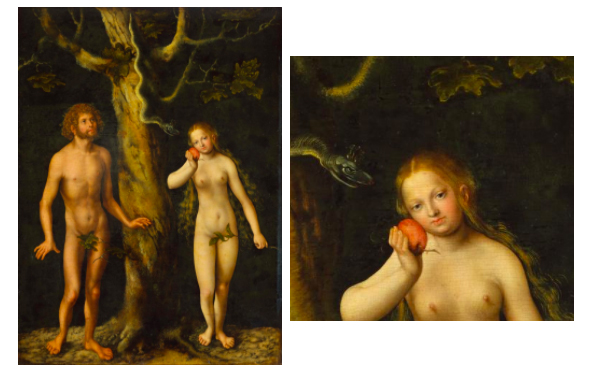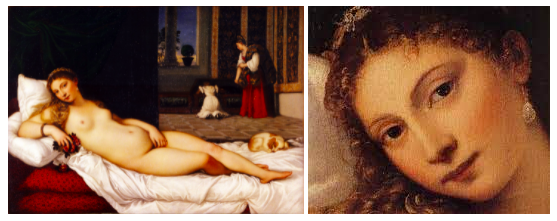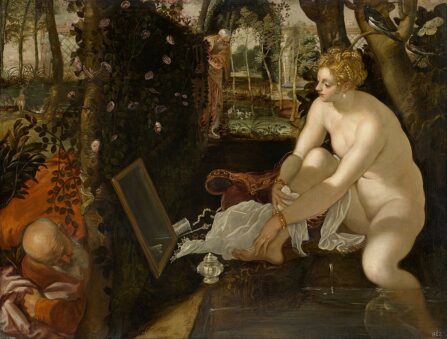Nudity as Art and Nakedness as Sin
A Strangely Unnatural Relationship
Nudity as Art and Nakedness as Sin
Artist and Muse
An artist’s subject is both integral and impressionable, often folding itself to the will of its viewer. A subject is invariably present, whether it be in the mind of its originator, its spectacor, or in the exact moment it comes into contact with a gaze. A subject becomes composed by the curious glances, the critical squints, and the stubbornly intense stares.
The supposed flirtations of sight distinguish themselves separately in depictions of nudity in oil paintings and photography. The process of painting is far more time-consuming, and arguably more intentional, than photographic depictions. Photography of the nude captures every raw detail of its subject—their blemishes, their fat, their sagging skin. It is, in a sense, a more sincere depiction of the nude. Painting, however, has been for too long obstructed by the corruptive projections of its creator and the curious glances of his audience. In an effort to draw consideration to the disproportionate number of nude paintings conceived by men, I have restricted myself to only investigating the particular relationship between male painters and their naked female muses.
The mediums of nude art share a particular point, however, which entirely concerns itself with what the spectator finds aesthetically pleasurable to gaze upon: Male depictions of female nudity are formed on the commodification, and thus the degradation, of women as an aesthetic, persecuting those who cannot be reproduced into this narrow perspective. Through subjugating women into existing as the primary subjects of nude European oil paintings, women have transformed into subjects of sights(Berger 54). In restricting this veiled and very literal mechanism, if possible, a woman’s body sheds its potential to be possessed, repurposed, and commodified.
I believed that female nudity was inherently subversive. The more I come to understand, however, the more I feel deceived by this belief.
Nudity and Nakedness
Nudity and nakedness must be addressed as two utterly separate entities. Nakedness is the exposing emotion of vulnerability; it is the act of being entirely stripped of something. Nakedness is not confined to just the human body: You can feel naked. You cannot feel nude. Nude is a shade of lipstick and the color of khakis. Nudity can be worn, while nakedness cannot. Nudity is to be naked, yes, however it is primarily concerned with the aesthetics of nakedness. Art depicts nudity, not nakedness. This is where we start.
Naturalness and Shame: Our Creation Story

The Book of Genesis tells us that when Eve ate God’s forbidden fruit from the tree of knowledge of good and evil, her and Adam became forcefully aware of their nakedness. They were overcome by an unbearable shame in looking upon one another’s exposed bodies. A woman’s bare body not only became punished and made reason for her subservience to man, but nakedness became altogether the antithesis to man and woman’s righteous preservation in society.
The state of nakedness is accompanied by naturalness and stillness. Nakedness is the human form—the natural state of human existence. It is the most permanent part of humanity. The state of nakedness is free. People, however, are fearfully distrubed by it: Like the condemnation of Adam and Eve, our own nakedness necessitates ostracism and expulsion. Nudity in art is rarely depicted on its own—with the exceptions of accessorizing the woman’s body with loose drapery, jewelry, a bedroom, or the nature around her. As in art, nakedness is adorned and embellished so conspicuously in order to remove its naturalness and rawness; through this rather desperate doing, the condition of nakedness is divorced from the state of social excommunication.
To be embellished and clothed, even as little as the unassuming necklace that dips between a woman’s breasts, is to be civilized. Nudity is often depicted in visionary worlds with mythical creatures and magnificent Gods to explain the fantastical, almost inhuman, essence of nakedness. Nakedness has become so illusory it can only be addressed, like a fable or a Biblical tale, in art. Through a canvas, nakedness transcends into its adorned form: Nudity.
The Spectacle and the Spectator
Renaissance depictions of Adam and Eve are concentrated in the exact moment of humankind’s expulsion from Eden—the “moment of shame.”1 Their contempt, however, becomes no longer contained between the subjects. It is directed to the spectator.2 Through crusted layers and stained canvas corners, we, art’s audience and the agents of an innately willful and curious sight, become completely consumed by and present with the subjects we look upon.
Our fascination with the nude in art is categorized as scopophilia, or the pleasure in looking.3 Scopophilia, as it relates to portrayals of nudity, is the manifestation of the patriarchal order in which “pleasure in looking has been split between active/male and passive/female.”4 Applied to nude art, scopophilia assumes a wholly unrealistic disposition of the female subject. It assumes that, in her most exposed and sensitive state, she enjoys being looked at: It is the “taking [of] other people as objects, subjecting them to a [control].”5
Women are always presented as nude and alone. Although the female subject may be literally depicted in the same frame as a male subject, the two are positioned in a manner that suggests no relation between the two; their bodies are not intimate with one another, but rather, the female subject often faces her body and gazes upon her assumed viewer. The engagement between the female subject and her viewer is a singular, interpersonal experience that visually excludes the woman’s male companion. They are often the sole subject of the piece, and the viewer is her audience. To believe that nude art is purely concerned with the aesthetic of the female body is to neglect the purpose it was made: To please the male viewer and fortify the suffering of women. Although she is physically still, her nudity performs within the painting for the viewer. She is “the bearer of meaning, not the maker.”6
The Male Gaze
The relationship between man and woman, as it relates to the nude art form, can be defined through the stark difference between looking at and to be looked at. Men, whether it be the artist or the viewer, observe women, watch women, gaze towards and down at women. Women, expressively or not, watch themselves being looked at.7 Women, through the act of being surveyed, are perceived as beautiful and nude objects. Stripped of clothing and bodily adornments, women are vulnerable to the intrusive and investigative male gaze. The man, who she does not know, sees her most intimate, private form.
A profoundly inseparable and latent notion of fantasy resides within nude art: The moment where the spectacle and the spectator’s eyes meet is completely imagined. The woman’s facial expression is presented as if expecting spectators. Her facial expression is painted on, and the power of her reaction is accorded to the painter and the spectator. Not her. In this way, the viewer assumes a sense of possession of the subject, recognizing her body and her nudity as his. The presentation of the subject projects the sense of a shared experience, a relationship between the viewer and the subject that is entirely dependent and formed by the spectator. The woman remains the same. She is, after all, unaware of her viewers.
Looking Through His Eyes
Day One as the Viewer: The Question of Ownership
I wonder where the eyes go first. To her eyes, to her hair, to her chest, to her slender, presumably clammy toes? My eyes lead me to how her body is positioned. She may be lying down with her arm wedged so her head is just barely lifted. Or she may be lying down with her arms behind her back for support. Or she is standing with her right (or left) knee slightly pushed forward, her hips leaned to one side, and her arms loosely draped by her waist’s side. I ask myself if it was the subject that chose to position herself in that manner, but I quickly realize it cannot be true. She is, in reality, a subject. She has absolutely no ownership of her own body as if she did, she would not have been sold at an art auction or hung in the Uffizi Gallery centuries after her death.

The genre of the Renaissance nude is particularly fascinating, as the woman’s face always presents the same expression: A rather static knowingness and awareness of her spectator’s gaze at her. It is unclear if she is engaged in this affair of sight as her face is neither emotional or emotionless. Her expression is impassive. It is as if her expression, her reaction, her emotion—her human-ness—was intentionally left bare and up to the surveyor. As if the woman herself was left to fill-in-the-blank.
The man as spectator is the reflection of the power he holds over the subject he surveys. The subjects of the Renaissance nude often look away from the others presented in the same frame, whether they be her presumed lover or otherwise; her gaze is directed toward “the one who considers himself her true lover—the spectator-owner.”8 The simple, yet profoundly degrading difference denotes the relationship between the male gaze and its spectacle, bleeding into the relationship women have with themselves: “The surveyor of women in herself is male: the surveyed female. Thus she turns herself into an object— and most particularly an object of vision: a sight.”9 The woman as a spectacle of nude art sees herself purely through the male gaze of the surveyor, and thus is unable to assert any ownership and sovereignty over her body and self. The composition of her whole being has been repurposed and confirmed by the artist’s subjectivity to please his viewers.10
Day Two as the Viewer: Gazing at One’s Self

I was taught in my early childhood about the reflection of Narcissus. Narcissus informs us that vanity leads to the decay of character and eventual death of the body. My exploration of the performance of nudity in art led me to the motif of mirrors. I became observant of the relationship and inclusion of mirrors in nude paintings. The addition of the mirror allows the woman to look at herself as if she was her own spectator; however, this addition projects the sense of vanity onto the woman—not onto the actual viewer. As the woman looks at herself through her viewer, she looks upon herself, firstly, as a sight.11 Through this catastrophic inclusion of the mirror, the woman’s admiration and curiosity about her own nudity and her own beauty is stamped as vain. An irony lies beneath this in that the woman is brought to life, she is painted for the pleasure of the viewer, but she is the one to be condemned for gazing upon her own nudity. The viewer is entitled to view it. As the hypothetical agent of the male gaze, I am just the modest appreciator of art.
Day Three as the Viewer: Nudity as Aesthetic Commodity
I find myself unable to remember her face. Cranach’s Eve becomes reduced to a figure holding an apple. Titian’s Venus becomes an image of melted and swirled beiges and reds. My memory of Susanna is overcome by a stressing reflection, rather than a formidable image, of how terribly uncomfortable it must be to sit naked in dried leaves and dampened dirt. In thought, the subjects’ faces are rendered nearly impossible to recall. The beige complexion of her posed figure, however, becomes a blurred yet recognizable form.
A woman’s face is rather insignificant in nude paintings. She is undoubtedly and expectantly attractive—as is her figure—or she would not have been considered by the artist and the spectator as fit to be a subject. The viewer finds validation in their own rationalization of her one-dimensional value in order to justify their own artistic taste and aesthetic eye. This empty interpretation of artistic taste has been fundamentally constructed on a woman devoid of her humanness and self. Her purpose is as a sight to the viewer: Her value has nothing to do with who she is, but who she is as subject of the artist’s painting. She is neither allegory nor person: She is the helpless casualty in the composition of what the viewer considers high-brow aesthetic appreciation and experience.
The composition of a facial expression is intrinsically human and emotional. In René Magritte’s Rape, a naked body has, as if in an effort to superimpose two images or thoughts, morphed over the woman’s face. She has become a monster of sorts. This painting is vulgar. It almost incites a certain visceral, nauseating reaction. This subject can no longer be appreciated and rationalized as pertaining to aesthetics. She can no longer be burned by the male gaze as Magritte’s subject is merely a reflection of the spectator themselves.
Rape is but an exemplary mirroring of the degradation of nakedness. Rape is not a nude painting. Rape is of a naked body. Through shocking nakedness, Magritte’s subject has already subverted her spectator; thus, she cannot look upon herself through his eyes. Through the eyes of the subject, the roles of spectator and spectacle are defined. Through the eyes of the subject, the spectator is given authority to bend and form his subject as he pleases. Through this, the subject becomes worthy only so far as she is an aesthetic commodity to her spectator. Magritte’s subject, however, has breasts for eyes.
Day Four as the Viewer: Coming Full Circle
I examine Philip Pearlstein’s Neon Mickey and Bouncy Duck, in which a woman sits on a seesaw, looking blankly in front of her.
I return to this thought of nakedness and nudity: One is aesthetic, one is scandalous. One speaks, and one does not—it is silent. I scroll through hundreds of nude Venuses, too fast to make eye contact with any of them. They are naked, yes, but nudity has overtaken them. Their nakedness has been ornamented. They are wearing their nakedness, as if their bodies are covered in an act of almost modesty. Nakedness is not to be shared, while nudity is not only shared as a commodity in art, but has become mass produced. Nudity is an aesthetic commodity of art, while nakedness is scarcely ever depicted. Nudity as an aesthetic must be reproduced to live.
Nudity is inherently defined by not only its commodification abilities, but its inherent relation to the male gaze, too. Through nakedness’s sheltered sense, it is able to subvert the male gaze simply by never meeting it. The presentation of bodies is seen first as a reproducing commodity, then an artistic aesthetic, and then it achieves cultural permanence.
A commodity has an owner other than itself, which brings it value. The owner of nudity is the male gaze and the spectator. The owner of nakedness is but the person who carries its body. It cannot be commodified as its owner possesses its self-autonomy. Nakedness lacks the reciprocal relationship between spectator (owner) and spectacle (commodity). Nakedness, which cannot be commodified and possessed by another, is thus demeaned as perverse and unusual.
I began to pick at the stitching of nakedness, like the fraying on jeans. What I discovered by the inseam was our fear of nakedness. Nakedness is a still, mute sensation that we experience each day. Only in solitude, however, do we experience its stinging silence.
Women are to cower in fright at the naturalness of their bodies. Nakedness is rejected as outrageous, whoreish, and scandalous. Nakedness is to be so separated from oneself for their own fear of being social ostracized. The paradox lies within the alienation of person and body, categorizing the inseparable as two separate entities.
The apple caused our original sin, not our nakedness.
- John Berger Ways of Seeing (British Broadcasting Corp, 1972), 56.
- Berger, Ways of Seeing, 55.
- Laura Mulvay, Visual and Other Pleasures (Routledge, 1989), 16.
- Mulvay, Visual and Other Pleasures,19.
- Mulvay, Visual and Other Pleasures, 16.
- Mulvay, Visual and Other Pleasures, 15.
- Berger, Ways of Seeing, 53.
- Berger’s Ways of Seeing 66.
- 53. Berger’s Ways of Seeing
- Berger, Ways of Seeing, 77.
- Berger, Ways of Seeing, 59.